
The slippery dick is a species of wrasse native to shallow, tropical waters of the western Atlantic Ocean.

The checkerboard wrasse is a fish belonging to the wrasse family. It is native to the area including the Indian Ocean to central Pacific Ocean.
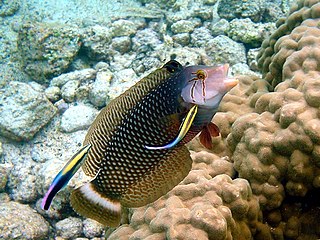
Novaculichthys taeniourus, also known as the rockmover wrasse, carpet wrasse, dragon wrasse, bar-cheeked wrasse, olive-scribbled wrasse or reindeer wrasse, is a species of wrasse mainly found in coral reefs and lagoons in the Indo-Pacific region. These include habitats in the Gulf of California to Panama; tropical Pacific Ocean islands including Hawaii; the Philippines, Indonesia and Australia; and the Indian Ocean to the east coast of Africa. The common name, "rockmover wrasse", comes from their behavior of upending small stones and reef fragments in search of prey. This species is the only known member of its genus.

Pomacanthus navarchus, the blue-girdled angelfish or majestic angelfish, is a marine angelfish from the Indo-Pacific region. It occasionally makes its way into the aquarium trade. P. navarchus is one of the smallest of the larger species of angelfish. It grows to a maximum length of 28 centimetres (11 in), but is usually much smaller than this, and can live to be up to 21 years old. Younger fish stay closer to the shallows, but the more mature fish can be found up to 120 feet (37 m) deep. Majestic angelfish eat mainly sponges and tunicates. Juvenile fish are mostly blue in color with white stripes. As they mature, they take on a yellow coloration on the flanks, dorsal fin, and tail.

The bird wrasse, Gomphosus varius, is a species of the wrasse family.
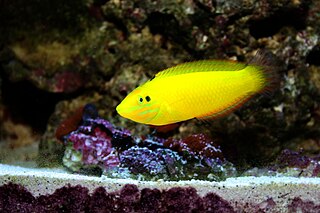
Halichoeres chrysus, commonly called the canary wrasse, golden wrasse or yellow wrasse, is a fish species in the wrasse family native to central Indo-Pacific area.
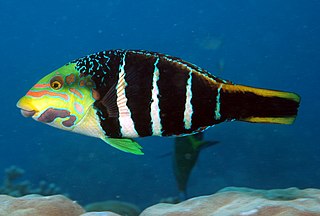
The barred thicklip wrasse, Hemigymnus fasciatus, is a species of fish belonging to the wrasse family, native from the Indo-Pacific.

The yellowhead wrasse is a fish species belonging to wrasse family native to shallow tropical waters in the Caribbean Sea and western Atlantic Ocean.
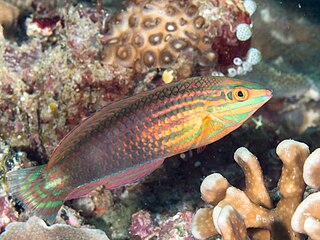
The red-lined wrasse, two-spotted wrasse or biocellated wrasse, Halichoeres biocellatus, is a species of wrasse native to shallow tropical waters in the western Pacific Ocean.

The slender grouper is a species of marine ray-finned fish, a grouper from the subfamily Epinephelinae which is part of the family Serranidae, which also includes the anthias and sea basses. It is the only species in the genus Anyperodon. It is found in the Indo-Pacific region.

Heniochus chrysostomus, also known as the threeband pennantfish, threeband bannerfish or pennant bannerfish, is a marine ray-finned fish, a butterflyfish from the family Chaetodontidae.It is found in the Indo-Pacific region.

Halichoeres maculipinna, the clown wrasse, is a species of tropical fish that lives throughout the Caribbean Sea and adjacent parts of the western Atlantic Ocean. It is a carnivorous, multi-colored wrasse that is common throughout its range.
The Weed wrasse, also known as Schwatz's wrasse or the seagrass wrasse, is a species of wrasse native to the Pacific ocean from Sumatra to Solomon Islands. It can be found in groups at depths from 1 to 4 m in seagrass beds and coral reefs. This species can reach 12 cm (4.7 in) in total length. Body is oval, rather elongated and laterally compressed. Adults are green and pinkish.

Halichoeres leucoxanthus, commonly called the Canarytop wrasse, Whitebelly wrasse, or Lemon meringue wrasse, is a fish species in the wrasse family endemic to the Indian Ocean.
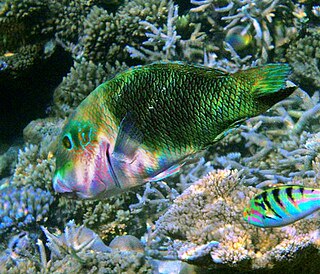
The Blackeye thicklip wrasse or Half-and-half wrasse is a species of fish belonging to the wrasse family. It is native to the Indo-Pacific.

Parupeneus pleurostigma, commonly known as the sidespot goatfish and round-spot goatfish, is a marine fish belonging to the family Mullidae.

Halichoeres prosopeion, commonly called the twotone wrasse, half-grey wrasse or zig-zag wrasse, is a fish species in the wrasse family native to the western Pacific Ocean.
Halichoeres richmondi, commonly called the Richmond's wrasse or chain-lined wrasse, is a fish species in the wrasse family native from the central Indo-Pacific.

The blackear wrasse is a species of wrasse, a type of fish in the family Labridae, from the warmer waters of the western Atlantic Ocean.

Pseudocoris heteroptera, the torpedo wrasse or zebra wrasse, is a species of marine ray-finned fish, a wrasse from the family Labridae. It is found in the western Pacific Ocean where it is associated with reefs.



















